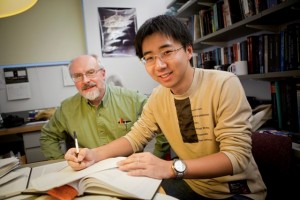
Peiyuan Mao ’11 performed radio astronomy research with Lyle Hoffman, professor of physics.
It’s not often an undergraduate finds an opportunity to conduct research that has never been done before, but that’s exactly what Peiyuan Mao ’11 did through a summer program at the Space Telescope Science Institute (STScI) in Baltimore, Md. His work could have implications in determining if there are habitable environments outside our solar system.
Mao (Yangzhou Jiangsu Province, China) began studying stellar flares after learning more about NASA’s Kepler project, which makes stellar flare research possible. Kepler is a space telescope with a wide field of view that can monitor more than 150,000 stars simultaneously. A flare is a sudden outburst of a star’s electromagnetic energy. Solar flare, which occurs occasionally, is potentially hazardous, disrupting electronics and communication by distorting the earth’s magnetic field.
“Stellar flares could be orders of magnitude more powerful than solar flares, damaging the ecosystem of the planet orbiting around the star,” explains Mao. “Studying stellar flare is crucial to the determination of the habitability of the orbiting planets. My project models the stellar flares to figure out their connection with different parameters so that their origin can be better understood. There are proposed theories about how flares are triggered, but they are incomplete and lack experimental evidence.”
Mao presented his research at the 217th American Astronomical Society meeting held in Seattle, Wash., Jan. 9-13. Because his research is related to Kepler, a hot topic in astronomy, it generated a lot of buzz. He is still receiving emails from attendees inquiring about his findings.
Mao enjoyed the challenge of tackling uncharted territory in the study of stellar flares.
“This is something no one has ever done before,” he says. “I had to create the research tools that I needed entirely on my own, and once I encountered obstacles, I was unlikely to find solutions from previous research. Another fun aspect of the project is that I got to work with leading scientists in the field, and I have learned a lot of things along the way.”
Among those scientists was David Soderblom, an astronomer at STScI, who advised Mao during his summer program. Mao was one of 16 undergraduate and graduate students from around the world selected for the 10-week program. In addition to his independent research into stellar flares, Mao attended twice weekly talks given by Nobel Prize laureates in physics as well as former astronauts and NASA directors. He also interacted with students from Europe, Asia, South America, and the U.S.
These experiences will definitely help Mao, who is pursuing B.S. degrees in mathematics and physics, as he applies to graduate programs. His Lafayette training served him well at STScI, and the College funded his travel and hotel stay for his conference presentation.
“I feel very fortunate to do research and present at a conference as an undergraduate,” he says. “When I was at STScI, very few people were from liberal arts colleges. During the American Astronomical Society meeting, most of the undergraduate presenters were from big universities, and students like me were rare to see. Most other liberal arts colleges either lack the opportunities to do undergraduate research or lack the money to support travel and presentations.”
Mao also performed radio astronomy research with Lyle Hoffman, professor of physics, as part of the Undergraduate ALFALFA (Arecibo Legacy Fast ALFA) survey program located at the Arecibo Observatory in San Juan, Puerto Rico. He also studied Hilbert space functional analysis under the guidance of , professor of mathematics, for his thesis.

1 Comment
Comments are closed.